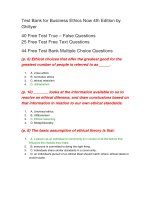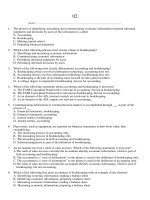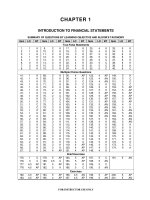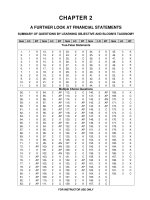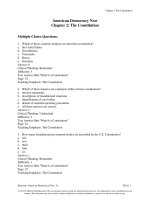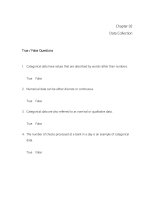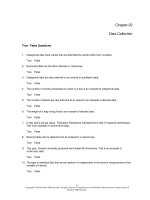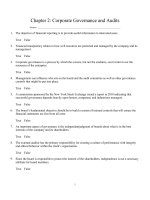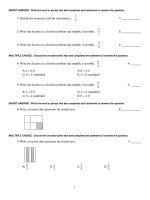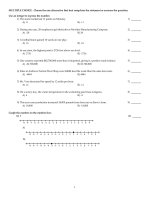Business ethics now 3rd edition ghillyer test bank
Bạn đang xem bản rút gọn của tài liệu. Xem và tải ngay bản đầy đủ của tài liệu tại đây (182.19 KB, 38 trang )
Chapter 002 Defining Business Ethics
True / False Questions
1. Business ethics involve the application of standards of moral behavior to business
situations.
True False
2. You can approach business ethics from two distinct perspectives: what is happening or
what should be happening.
True False
3. You can approach business ethics from two distinct perspectives: a descriptive summation
of the customs, attitudes, and rules that are observed within a business or a normative
evaluation of the degree to which the observed customs, attitudes, and rules can be said to be
ethical.
True False
4. Business ethics should be applied as a set of moral standards or ethical concepts separate
from general ethics.
True False
5. Shareholders are anyone with a share or interest in a business enterprise.
True False
6. Stakeholders are anyone with a share or interest in a company.
True False
7. Stakeholders include stockholders, employees, and the federal government.
True False
2-1
Chapter 002 Defining Business Ethics
8. Unethical corporate behavior could negatively impact a community due to an economic
decline.
True False
9. Unethical corporate behavior could negatively impact suppliers because of false and
misleading financial information.
True False
10. An organization's unethical behavior can affect creditors by leading to a failure to repay
debt according to an agreed schedule.
True False
11. A negative impact from unethical corporate behavior for creditors could be the loss of
employment.
True False
12. The standard of corporate governance is the extent to which the officers of a corporation
are fulfilling the duties and responsibilities of their offices to the relevant stakeholders.
True False
13. The standard of corporate governance appears to be at the highest level in business
history.
True False
14. An oxymoron is the combination of two contradictory terms, such as "deafening silence"
or "jumbo shrimp."
True False
2-2
Chapter 002 Defining Business Ethics
15. Government efficiency could be considered an oxymoron.
True False
16. "Government efficiency" and "Central Intelligence Agency" can be considered an
oxymoron.
True False
17. A code of ethics is a company's written standards of ethical behavior that are designed to
guide managers and employees in making the decisions and choices they face every day.
True False
18. A code of ethics is a company's unwritten standards of ethical behavior that are designed
to guide managers and employees in making the decisions and choices they face every day.
True False
19. The positive outcome of unethical behavior in the business world has been increased
attention to the need for third-party guarantees of ethical conduct and active commitments
from the rest of the business world.
True False
20. The Ethics Resource Center defines a code of ethics as a central guide to support day-today decision making at work.
True False
21. The code of ethics serves as a message to the organization's stakeholders and should
represent a clear corporate commitment to the highest standards of ethical behavior.
True False
2-3
Chapter 002 Defining Business Ethics
22. Written standards of ethical behavior designed to guide a company's managers and
employees make daily decisions refer to a Corporate Social Responsibility Statement.
True False
23. Typically, a company's code of ethics is a public document.
True False
24. The code of ethics should represent a clear guide to managers and employees in making
the decisions and choices they face every day.
True False
25. A code of ethics usually cannot be easily sidestepped or ignored.
True False
26. The issue of corporate social responsibility has advanced from an abstract debate to a core
performance assessment issue with clearly established legal liabilities.
True False
27. Over the last four decades, corporate ethics has remained in the organizational
mainstream.
True False
28. Codes of ethics are still typically cosmetic public relations documents, and very few
organizations are attempting to share them with all their stakeholders.
True False
2-4
Chapter 002 Defining Business Ethics
29. The 2002 Sarbanes-Oxley Act introduced greater accountability for chief executive
officers and boards of directors by requiring them to sign off on the financial performance
records of the organizations they represent.
True False
30. Because of the Sarbanes-Oxley Act, today, when employees are asked to do something
that conflicts with their own personal values, seldom is the guidance from companies a series
of clichés.
True False
31. "Do what's legal" is an ethical cliché.
True False
32. "Do what I d" is an ethical cliché.
True False
33. In resolving a truth versus loyalty dilemma, you must decide whether the decision will
have short-term or long-term consequences.
True False
34. In resolving a justice versus mercy dilemma, you must answer whether you perceive the
issue as a question of dispensing justice or mercy.
True False
35. An ethical dilemma is a situation in which there is a "right" versus "right" answer.
True False
2-5
Chapter 002 Defining Business Ethics
36. Once you have reached a decision as to the type of conflict you are facing, the three
resolution principles are: ends-based, rules-based, and the Golden Rule.
True False
37. If you utilize the rules-based resolution principle, you would consider which decision
would provide the greatest good for the greatest number of people.
True False
38. If you utilize the Golden Rule resolution principle, you would utilize the principle: do unto
others as you would have them do unto you.
True False
39. Andrew Young's statement, "Nothing is illegal if a hundred businessmen decide to do it"
is one of the commonly held rationalizations that can lead to misconduct.
True False
40. A belief that the activity is safe because it will never be found out or publicized is one of
the commonly held rationalizations that can lead to misconduct.
True False
41. The Golden Rule resolution principle considers what would happen if everyone made the
same decision as you.
True False
2-6
Chapter 002 Defining Business Ethics
Multiple Choice Questions
42. _______ is the application of ethical standards to business behavior.
A. Corporate social responsibility
B. Philanthropy
C. Business ethics
D. Corporate culture
43. Business ethics can be approached using the _______ and _______ perspectives.
A. classical, modern
B. descriptive, normative
C. philosophical, realist
D. actual, hypothetical
44. A _______ perspective is a summation of the customs, attitudes, and rules that are
observed within a business.
A. descriptive
B. normative
C. prescriptive
D. philosophical
45. _______ is someone with a share or interest in a business enterprise.
A. Shareholders
B. Board of directors
C. Stakeholders
D. Employees
46. All of the following are stakeholders except _____.
A. customers
B. federal government
C. competitors
D. community
2-7
Chapter 002 Defining Business Ethics
47. Unethical corporate behavior could negatively impact customers due to _______.
A. poor service quality
B. loss of employment
C. loss of stock value
D. loss of principle and interest payments
48. Unethical corporate behavior could negatively impact employees due to_______.
A. loss of stock value
B. loss of employment
C. poor service quality
D. loss of principle and interest payments
49. Unethical corporate behavior could negatively impact the federal government due to
_____.
A. false and misleading financial information used to make investment decisions
B. loss of employment
C. economic uptick
D. the loss of tax code
50. _______ is the system that directs and controls business corporations.
A. Local governance
B. State governance
C. Federal governance
D. Corporate governance
51. A(n) _______ is the combination of two contradictory terms.
A. oxymoron
B. synonym
C. antonym
D. metaphor
2-8
Chapter 002 Defining Business Ethics
52. All of the following are oxymorons except:
A. government efficiency
B. authentic reproduction
C. Central Intelligence Agency
D. lifetime warranty
53. A(n) _______ is the written standards of ethical behavior designed to guide a company's
managers and employees as they make daily decisions.
A. code of ethics
B. code of morality
C. code of conduct
D. employee handbook
54. The ______ introduced greater accountability for chief executive officers and boards of
directors by requiring them to signing off on the financial performance records of the
organizations they represent.
A. Global Sullivan Principals
B. Federal Corrupt Practices Act
C. 2002 Sarbanes-Oxley Act
D. False Claims Act
55. The issue of ______ has advanced from an abstract debate to a core performance
assessment issue with clearly established legal liabilities.
A. corporate ethics
B. corporate social responsibility
C. corporate donations
D. corporate community involvement
2-9
Chapter 002 Defining Business Ethics
56. _______ have matured from cosmetic public relations documents into performancemeasurement documents which an increasing number of organizations are now committing to
share with all their stakeholders.
A. Code of ethics
B. 2002 Sarbanes-Oxley Act
C. Federal Corrupt Practices Act
D. Global Sullivan Principles
57. According to the text, which of the following is not an ethical cliché?
A. Do what's legal
B. Consult the company code of ethics
C. Do what I do
D. Do what you think is best
58. A situation in which there is no obvious "right" or "wrong" decision, but rather a "right"
or "right" answer, refers to which of the following:
A. ethical dilemma
B. moral manifestation
C. absolute ethics
D. unethical dilemma
59. During the 1960s, a major ethical dilemma was _______.
A. deceptive advertising
B. cyber crime
C. human rights issues
D. honesty
60. _______ was/were a major ethical dilemma in the 1980s.
A. Drug use escalation
B. A changing work ethic
C. Bribes and illegal contracting practices
D. International corruption
2-10
Chapter 002 Defining Business Ethics
61. _______ was/were a business ethics development in the 1990s.
A. Class action lawsuits
B. The Federal Corrupt Practices Act
C. The establishment of the Defense Industry Initiative
D. The growth of anticorruption efforts
62. In which type of conflict would you face the following question: Do you tell the truth or
remain loyal to the person or organization asking you not to reveal the truth?
A. Short-term versus long-term
B. Justice versus mercy
C. Truth versus loyalty
D. Individual versus community
63. Which of the following is not a resolution principle?
A. Rules-based
B. The Golden Rule
C. Rationalization-endured
D. Ends-based
64. The _______ resolution considers what would happen if everyone made the same decision
as you.
A. rules-based
B. ends-based
C. Golden Rule
D. similarity-based
Fill in the Blank Questions
65. ________________________ is the application of ethical standards to business behavior.
________________________________________
2-11
Chapter 002 Defining Business Ethics
66. A _____________________ perspective is a summation of the customs, attitudes, and
rules that are observed within a business.
________________________________________
67. A ____________________ is someone with a share or interest in a business enterprise.
________________________________________
68. Corporate ____________________ is the system that directs and controls business
corporations.
________________________________________
69. An ____________________ is the combination of two contradictory terms.
________________________________________
70. A _______________________ is the written standards of ethical behavior designed to
guide a company's managers and employees as they make daily decisions.
________________________________________
71. The _______________________________ introduced greater accountability for chief
executive officers and boards of directors by requiring them to signing off on the financial
performance records of the organizations they represent.
________________________________________
72. A ______________________________ is a situation in which there is no obvious "right"
or "wrong" decision, but rather a "right" or "right" answer.
________________________________________
2-12
Chapter 002 Defining Business Ethics
Essay Questions
73. Name and discuss three stakeholders' interests in an organization.
74. Do you agree that the standard for corporate governance appears to be at the lowest level
in business history? Explain.
75. Define an oxymoron. Give an example of an oxymoron, and explain why it is an
oxymoron.
76. What is the purpose of a code of ethics for an organization?
2-13
Chapter 002 Defining Business Ethics
77. Describe and discuss dramatic changes that have taken place in the business environment
over the last four decades.
78. Define ethical dilemma. Give an example of an ethical dilemma. Discuss the type of
conflict you are dealing with. Discuss the resolution principle you would use to resolve the
ethical dilemma.
79. Discuss one of the four commonly held rationalizations, identified by Saul Gellerman, that
can lead to misconduct.
80. Discuss two of the four commonly held rationalizations, identified by Saul Gellerman,
that can lead to misconduct.
2-14
Chapter 002 Defining Business Ethics Key
True / False Questions
1. (p. 22) Business ethics involve the application of standards of moral behavior to business
situations.
TRUE
Bloom's: Remembering
Difficulty: Easy
Learning Outcome: 2.1
2. (p. 22) You can approach business ethics from two distinct perspectives: what is happening or
what should be happening.
TRUE
Bloom's: Remembering
Difficulty: Easy
Learning Outcome: 2.1
3. (p. 22) You can approach business ethics from two distinct perspectives: a descriptive
summation of the customs, attitudes, and rules that are observed within a business or a
normative evaluation of the degree to which the observed customs, attitudes, and rules can be
said to be ethical.
TRUE
Bloom's: Remembering
Difficulty: Easy
Learning Outcome: 2.1
2-15
Chapter 002 Defining Business Ethics Key
4. (p. 22) Business ethics should be applied as a set of moral standards or ethical concepts
separate from general ethics.
FALSE
Business ethics should not be applied as a separate set of moral standards or ethical concepts
from general ethics.
Bloom's: Remembering
Difficulty: Easy
Learning Outcome: 2.1
5. (p. 22) Shareholders are anyone with a share or interest in a business enterprise.
FALSE
Stakeholders are anyone with a share or interest in a business enterprise.
Bloom's: Remembering
Difficulty: Easy
Learning Outcome: 2.2
6. (p. 22) Stakeholders are anyone with a share or interest in a company.
TRUE
Bloom's: Remembering
Difficulty: Easy
Learning Outcome: 2.2
7. (p. 22) Stakeholders include stockholders, employees, and the federal government.
TRUE
Bloom's: Remembering
Difficulty: Easy
Learning Outcome: 2.2
2-16
Chapter 002 Defining Business Ethics Key
8. (p. 22) Unethical corporate behavior could negatively impact a community due to an
economic decline.
TRUE
Bloom's: Remembering
Difficulty: Easy
Learning Outcome: 2.2
9. (p. 22-23) Unethical corporate behavior could negatively impact suppliers because of false and
misleading financial information.
FALSE
Unethical corporate behavior could negatively impact stockholders or shareholders because
of false and misleading financial information on which to base investment decisions.
Bloom's: Understanding
Difficulty: Medium
Learning Outcome: 2.2
10. (p. 22) An organization's unethical behavior can affect creditors by leading to a failure to
repay debt according to an agreed schedule.
TRUE
Bloom's: Remembering
Difficulty: Easy
Learning Outcome: 2.2
11. (p. 22) A negative impact from unethical corporate behavior for creditors could be the loss
of employment.
FALSE
A negative impact from unethical corporate behavior for creditors could be principal and
interest payments and repayment of debt according to the agreed schedule.
Bloom's: Understanding
Difficulty: Medium
Learning Outcome: 2.2
2-17
Chapter 002 Defining Business Ethics Key
12. (p. 23) The standard of corporate governance is the extent to which the officers of a
corporation are fulfilling the duties and responsibilities of their offices to the relevant
stakeholders.
TRUE
Bloom's: Remembering
Difficulty: Easy
Learning Outcome: 2.3
13. (p. 23) The standard of corporate governance appears to be at the highest level in business
history.
FALSE
The standard of corporate governance appears to be at the lowest level in business history.
Bloom's: Remembering
Difficulty: Easy
Learning Outcome: 2.3
14. (p. 24) An oxymoron is the combination of two contradictory terms, such as "deafening
silence" or "jumbo shrimp."
TRUE
Bloom's: Remembering
Difficulty: Easy
Learning Outcome: 2.3
15. (p. 25) Government efficiency could be considered an oxymoron.
TRUE
Bloom's: Remembering
Difficulty: Easy
Learning Outcome: 2.3
2-18
Chapter 002 Defining Business Ethics Key
16. (p. 25) "Government efficiency" and "Central Intelligence Agency" can be considered an
oxymoron.
TRUE
Bloom's: Remembering
Difficulty: Easy
Learning Outcome: 2.3
17. (p. 25) A code of ethics is a company's written standards of ethical behavior that are
designed to guide managers and employees in making the decisions and choices they face
every day.
TRUE
Bloom's: Remembering
Difficulty: Easy
Learning Outcome: 2.3
18. (p. 25) A code of ethics is a company's unwritten standards of ethical behavior that are
designed to guide managers and employees in making the decisions and choices they face
every day.
FALSE
A code of ethics is a company's written standards of ethical behavior.
Bloom's: Remembering
Difficulty: Medium
Learning Outcome: 2.3
19. (p. 24) The positive outcome of unethical behavior in the business world has been increased
attention to the need for third-party guarantees of ethical conduct and active commitments
from the rest of the business world.
TRUE
Bloom's: Remembering
Difficulty: Easy
Learning Outcome: 2.3
2-19
Chapter 002 Defining Business Ethics Key
20. (p. 24) The Ethics Resource Center defines a code of ethics as a central guide to support dayto-day decision making at work.
TRUE
Bloom's: Remembering
Difficulty: Easy
Learning Outcome: 2.3
21. (p. 25) The code of ethics serves as a message to the organization's stakeholders and should
represent a clear corporate commitment to the highest standards of ethical behavior.
TRUE
Bloom's: Remembering
Difficulty: Easy
Learning Outcome: 2.3
22. (p. 25) Written standards of ethical behavior designed to guide a company's managers and
employees make daily decisions refer to a Corporate Social Responsibility Statement.
FALSE
The company's written standards of ethical behavior is a code of ethics.
Bloom's: Remembering
Difficulty: Easy
Learning Outcome: 2.3
23. (p. 26) Typically, a company's code of ethics is a public document.
FALSE
The code of ethics typically is an internal document.
Bloom's: Remembering
Difficulty: Medium
Learning Outcome: 2.3
2-20
Chapter 002 Defining Business Ethics Key
24. (p. 26) The code of ethics should represent a clear guide to managers and employees in
making the decisions and choices they face every day.
TRUE
Bloom's: Remembering
Difficulty: Easy
Learning Outcome: 2.3
25. (p. 26) A code of ethics usually cannot be easily sidestepped or ignored.
FALSE
As seen in many of the case studies and discussion exercises in the textbook, a code of ethics
can be easily sidestepped or ignored by any organization.
Bloom's: Remembering
Difficulty: Medium
Learning Outcome: 2.3
26. (p. 26) The issue of corporate social responsibility has advanced from an abstract debate to a
core performance assessment issue with clearly established legal liabilities.
TRUE
Bloom's: Remembering
Difficulty: Easy
Learning Outcome: 2.4
27. (p. 26) Over the last four decades, corporate ethics has remained in the organizational
mainstream.
FALSE
Corporate ethics has moved from the domain of legal and human resource departments into
the organizational mainstream.
Bloom's: Remembering
Difficulty: Easy
Learning Outcome: 2.4
2-21
Chapter 002 Defining Business Ethics Key
28. (p. 26) Codes of ethics are still typically cosmetic public relations documents, and very few
organizations are attempting to share them with all their stakeholders.
FALSE
Codes of ethics have matured from cosmetic public relations documents into performance
measurement documents that an increasing number of organizations are now committing to
share with all their stakeholders.
Bloom's: Remembering
Difficulty: Medium
Learning Outcome: 2.4
29. (p. 26) The 2002 Sarbanes-Oxley Act introduced greater accountability for chief executive
officers and boards of directors by requiring them to sign off on the financial performance
records of the organizations they represent.
TRUE
Bloom's: Remembering
Difficulty: Easy
30. (p. 26) Because of the Sarbanes-Oxley Act, today, when employees are asked to do
something that conflicts with their own personal values, seldom is the guidance from
companies a series of clichés.
FALSE
Today when employees observe unethical behavior or are asked to do something that conflicts
with their own personal values, the extent of the guidance available to them still is often
nothing more than a series of clichés.
Bloom's: Understanding
Difficulty: Medium
Learning Outcome: 2.4
2-22
Chapter 002 Defining Business Ethics Key
31. (p. 28) "Do what's legal" is an ethical cliché.
TRUE
Bloom's: Remembering
Difficulty: Easy
Learning Outcome: 2.4
32. (p. 28) "Do what I d" is an ethical cliché.
FALSE
"Do what you think is best," "use your best judgment," or "do the right thing" would be
clichés.
Bloom's: Understanding
Difficulty: Medium
Learning Outcome: 2.4
33. (p. 28) In resolving a truth versus loyalty dilemma, you must decide whether the decision
will have short-term or long-term consequences.
FALSE
In resolving a truth versus loyalty dilemma, you must decide if you tell the truth or remain
loyal to the person or organization that is asking you not to reveal that truth.
Bloom's: Understanding
Difficulty: Medium
Learning Outcome: 2.5
34. (p. 28) In resolving a justice versus mercy dilemma, you must answer whether you perceive
the issue as a question of dispensing justice or mercy.
TRUE
Bloom's: Remembering
Difficulty: Easy
Learning Outcome: 2.5
2-23
Chapter 002 Defining Business Ethics Key
35. (p. 28) An ethical dilemma is a situation in which there is a "right" versus "right" answer.
TRUE
Bloom's: Remembering
Difficulty: Easy
Learning Outcome: 2.5
36. (p. 29) Once you have reached a decision as to the type of conflict you are facing, the three
resolution principles are: ends-based, rules-based, and the Golden Rule.
TRUE
Bloom's: Remembering
Difficulty: Easy
Learning Outcome: 2.5
37. (p. 29) If you utilize the rules-based resolution principle, you would consider which decision
would provide the greatest good for the greatest number of people.
FALSE
If you utilize the rules-based resolution principle, you would ask what would happen if
everyone made the same decision as you?
Bloom's: Remembering
Difficulty: Medium
Learning Outcome: 2.5
38. (p. 29) If you utilize the Golden Rule resolution principle, you would utilize the principle: do
unto others as you would have them do unto you.
TRUE
Bloom's: Remembering
Difficulty: Medium
Learning Outcome: 2.5
2-24
Chapter 002 Defining Business Ethics Key
39. (p. 30) Andrew Young's statement, "Nothing is illegal if a hundred businessmen decide to do
it" is one of the commonly held rationalizations that can lead to misconduct.
TRUE
Bloom's: Remembering
Difficulty: Easy
Learning Outcome: 2.6
40. (p. 30) A belief that the activity is safe because it will never be found out or publicized is
one of the commonly held rationalizations that can lead to misconduct.
TRUE
Bloom's: Remembering
Difficulty: Medium
Learning Outcome: 2.6
41. (p. 30) The Golden Rule resolution principle considers what would happen if everyone made
the same decision as you.
FALSE
The Golden Rule resolution principle considers do unto others as you would have them do
unto you.
Bloom's: Understanding
Difficulty: Medium
Learning Outcome: 2.6
2-25
